How to clean a firearm
by Technical Advisor Brendan Atkinson
Firearms work better, shoot straighter and last longer if they are properly maintained and treated with respect. A large part of this maintenance involves the proper cleaning and care of the working mechanisms and the all-important bore.
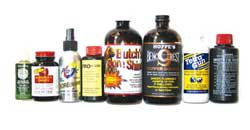 What I consider to be the best method of cleaning firearms may differ from the opinion of others. I base my cleaning routines on the way I clean my benchrest target rifles, and I continue to use these procedures down through the rest of my hunting firearms. Benchrest rifles are the Formula One of the centrefire rifle world. They incorporate every possible piece of technology to produce incredibly small groups. A large part of this is the use of stainless steel match-grade barrels, which can cost more than $800 when fitted to an action. We do not use dubious methods when dealing with such precision instruments. If it works with these barrels, it certainly works on firearms not requiring such pinpoint accuracy. Having said that, what shooter would not want his/her firearm to be as accurate as possible?
What I consider to be the best method of cleaning firearms may differ from the opinion of others. I base my cleaning routines on the way I clean my benchrest target rifles, and I continue to use these procedures down through the rest of my hunting firearms. Benchrest rifles are the Formula One of the centrefire rifle world. They incorporate every possible piece of technology to produce incredibly small groups. A large part of this is the use of stainless steel match-grade barrels, which can cost more than $800 when fitted to an action. We do not use dubious methods when dealing with such precision instruments. If it works with these barrels, it certainly works on firearms not requiring such pinpoint accuracy. Having said that, what shooter would not want his/her firearm to be as accurate as possible?
When a firearm is discharged, particles of burnt powder and primer residue are left in the bore, along with copper or lead-fouling depending on what bullets are being used. The next shot causes the bullet to pass over the fouling and so on for subsequent shots. If the firearm is neglected and many shots fired, a sandwich build-up of fouling can occur in the bore, especially just in front of the chamber. This, in effect, reduces the size of the bore and can result in a rise in pressure - in extreme cases, copper-clad bullets can be swaged down by this fouling so they exit the bore slightly undersized, and this is why fouling causes accuracy to drop off as more shots are fired. This can happen in a little as 20 shots in some barrels. Lead bullets, such as those fired in pistols and rimfires, are less affected by this problem, but will still perform better in a clean bore. A firearm that has been left in an unclean state for a long time may also have a pitted bore, which will not become obvious until it is cleaned thoroughly. Of course, by then it is too late. Shotgun shooters have an additional problem, in that plastic fouling from the wads used to hold the shot can sometimes leave a very stubborn type of fouling in the bore. Special brushes are available to help remove this.
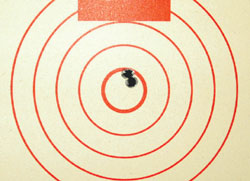 So, let’s have a look at some cleaning methods.
So, let’s have a look at some cleaning methods.
Firstly, it is a great help to the shooter to have some sort of cleaning cradle upon which to rest the firearm. If one already has a set of benchrest stands, they will do the job nicely. If not, make a cleaning cradle from a wooden box - cut a six-centimetre ‘V’ in both ends, and put some padding on the ‘V’ surface to protect the finish of the firearm. Inside the box, place all the cleaning gear apart from the cleaning-rod - it keeps things tidy.
The basic items needed for bore-cleaning consist of the following:
- a one-piece cleaning-rod of appropriate length and diameter
- bronze bristle brushes of the correct bore size
- a nylon bristle brush as above
- a suitable brass patch jag
- a good supply of cotton patches
- a good quality bore (powder) solvent
- a good quality copper solvent for stubborn fouling
- a small glass jar filled with white spirits or Shellite
- a tin of Kroil (USA) or Penetrene (Aus) lubricant
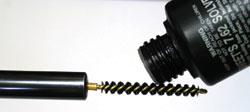 The easiest type of fouling to remove is the loose powder type that can actually be seen by inspecting the bore after firing. To do this, spear a patch of the correct size on a brass jag and anoint it with bore solvent. Pass this patch through the bore and out of the muzzle. It will be stained with black residue and under no circumstances should be pulled back through the bore. Remember that carbon is one of the hardest substances known to man and dragging it back through the bore will damage it. Allow the patch to fall off the jag as the rod is withdrawn through the muzzle. Pass further patches with bore solvent through the bore until they come out clean. Do not skimp on patches, as they are much cheaper than barrels. At this stage, most of the powder and primer fouling (the black stuff) will have been removed.
The easiest type of fouling to remove is the loose powder type that can actually be seen by inspecting the bore after firing. To do this, spear a patch of the correct size on a brass jag and anoint it with bore solvent. Pass this patch through the bore and out of the muzzle. It will be stained with black residue and under no circumstances should be pulled back through the bore. Remember that carbon is one of the hardest substances known to man and dragging it back through the bore will damage it. Allow the patch to fall off the jag as the rod is withdrawn through the muzzle. Pass further patches with bore solvent through the bore until they come out clean. Do not skimp on patches, as they are much cheaper than barrels. At this stage, most of the powder and primer fouling (the black stuff) will have been removed.
Take a bronze bristle brush of the correct diameter for the bore, and pass it through the barrel from the chamber end until it is fully exposed in front of the muzzle. Place about ten drops of bore solvent along its length and by using the cleaning rod make about ten passes through the bore all the way through. If the brush is anointed with solvent before inserting it into the barrel, there is a risk that drops may fall into the magazine and trigger area. Before doing anything else, rinse off the bronze brush in the jar of Shellite, to remove fouling particles and the old solvent. Never leave a bronze brush wet with solvent for any length of time - the solvent is designed to attack copper, and that means it attacks the brush as well, which will cause bristles to fall out.
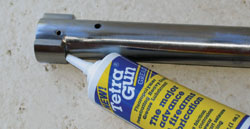 It is a good idea to use a bore-guide when cleaning rifles, as this will help prevent solvent and loose bristles falling into the wrong areas. A bore-guide is just that - it prevents the cleaning rod from contacting the sensitive throat area of the barrel. Many barrels have been ruined by ham-fisted cleaning, which in severe cases has cut a groove in the throat of the barrel at the three o’clock position for right-handers and the opposite for lefties. Can you guess why? Firearms such as pump action rifles and shotguns (and some lever actions) have to be cleaned from the muzzle end, and a muzzle protecting rod-guide is an absolute must to prevent damage to the crown.
It is a good idea to use a bore-guide when cleaning rifles, as this will help prevent solvent and loose bristles falling into the wrong areas. A bore-guide is just that - it prevents the cleaning rod from contacting the sensitive throat area of the barrel. Many barrels have been ruined by ham-fisted cleaning, which in severe cases has cut a groove in the throat of the barrel at the three o’clock position for right-handers and the opposite for lefties. Can you guess why? Firearms such as pump action rifles and shotguns (and some lever actions) have to be cleaned from the muzzle end, and a muzzle protecting rod-guide is an absolute must to prevent damage to the crown.
At this point, it is a good idea to run a couple of wet patches through to remove what the bronze brush has loosened up. Don’t be surprised if they come out very black, as the brush will locate any ingrained powder fouling. When the patches come out unstained, it’s in with the bronze brush again for another ten or so strokes. Hopefully this time the patches will come out almost clean. Two more wet, and one dry patch and you are done. Or are you?
Looking up the bore may give the impression that everything is shiny and clean, but is it? To test this out, use the nylon bristle brush and anoint the barrel with solvent. Now leave the barrel for some hours, preferably overnight, muzzle down in your gun safe - never muzzle up, as solvent will run back into the action and trigger area. Read the instructions on the bore solvent bottle, as some solvents are not recommended for overnight soaking, usually the ones that have an ammonia base.
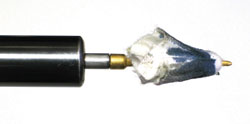 Next day, pass a patch through the bore. If
there are any green or blue traces on it, there is still copper fouling
present. If severe, the bronze brush should be used to get it out, but
if it is just a faint amount of color, then another soak will probably
finish the job.
Next day, pass a patch through the bore. If
there are any green or blue traces on it, there is still copper fouling
present. If severe, the bronze brush should be used to get it out, but
if it is just a faint amount of color, then another soak will probably
finish the job.
For really stubborn copper fouling, there are specific copper removing solvents. The best known is probably Sweet’s 7.62, an Aussie-made ammonia-based solvent that has received wide acceptance both in Australia and abroad. It is applied to the bore with a nylon bristle brush (never use a bronze brush) and left to sit for about ten minutes per application. Believe me, if there is any copper in there this stuff will find it and remove it. Rinse the brush off in warm tap water after use. Patch-out the barrel until dry, then pass a patch through, lightly anointed with Kroil, Penetrene or gun oil to prevent rust.
The above method applies to rifles, but can be adapted to pistols and shotguns by using the appropriate-sized rods and brushes. Revolver shooters have six chambers to clean in addition to the barrel.
With the bore taken care of, we need to look at the rest of the firearm. If it has been used in wet or dusty conditions, it is a good idea to take the barrelled action out of the stock and give the trigger a clean by using one of the modern spray-type gun cleaners. A very small dab of moly-based grease on the sears is all that is required and all metal parts should be given a wipe-over with a cloth, lightly anointed with good gun oil. Lightly means just that - enough to prevent rust, but not enough to attract dust. Always lubricate the locking lugs of the bolt to prevent galling. With shotguns, put a little lubrication on the knuckles of the action. Always lubricate the bore when storing any firearm for some time. Synthetic stocks only need a rub with a damp cloth, but for wooden ones, any of the good furniture polishes will make them look like new.
